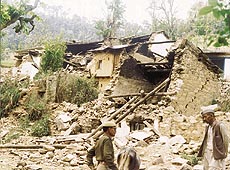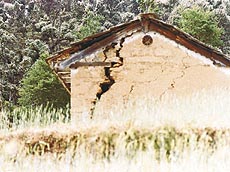Fragile
Himalayas
By Shamim
THE devastating earthquake which
struck the Garhwal Himalayas on the night of March 28,
1999, killing 100 persons, injuring 324 and rendering
thousands homeless, has again pointed towards the
fragility of the Himalayas and the need to re-focus the
development strategies in the entire Himalayan belt
stretching from Jammu and Kashmir to the North-East.
Large-scale death and
destruction caused by the seismic activity on that
fateful night has left lakhs of people homeless in
Chamoli, Rudraprayag, Tehri and Pauri districts of
Garhwal division and Bageshwar district of Kumaon
division.
 Chamoli district, which was the epicentre
of the earthquake, witnessed 60 deaths, followed by 34
deaths in Rudraprayag district. In Chamoli district alone
1256 villages were affected, having a population of
nearly 3 lakh. Chamoli district, which was the epicentre
of the earthquake, witnessed 60 deaths, followed by 34
deaths in Rudraprayag district. In Chamoli district alone
1256 villages were affected, having a population of
nearly 3 lakh.
But the most unfortunate
were the residents of the newly created Rudraprayag
district. In August last year, the district, particularly
the Ukkimath area, bore the brunt of massive landslides
which killed more than 60 persons and destroyed many
villages. Now the earthquake has further added to the
woes of the poor residents.
"The Garhwal region
has gone further backwards by two generations after this
tragedy, as it takes decades for the poor hill people to
build pucca houses," lamented Anil Joshi of
Himalayan Environmental Studies and Conservation
Organisation (HESCO), a non-government body engaged in
the relief operations.
B.M. Vohra, Divisional
Commissioner, Garhwal said that according to a
preliminary survey, 7500 houses were damaged or destroyed
in Chamoli district. In Tehri district 616 houses were
totally damaged and 2000 houses were partially damaged,
in Rudraprayag district 750 houses were completely razed
to the ground, while 3160 houses were partially damaged.
A survey has been going on to assess the damage to public
property. Many roads which were blocked or damaged by the
earthquake need repairs.
The people are afraid to
sleep inside their damaged homes as tremors are
continuing since March 28 in the region. They are forced
to spend their nights in the open. It is not only the
tremors which the villagers dread but the danger of wild
animals, particularly the maneater panthers and leopards
on the prowl, which has made their lives miserable.
More than the rations
people require tents and tarpaulins to save themselves
from the vagaries of weather and the wild animals.
Vohra said that a total
of 3200 tents and 20,000 tarpaulins have been distributed
in the quake affected region. But demands for more tents
have been pouring in from all the effected districts.
Many social and voluntary organisations, besides the Army
and the Indo-Tibetan Border Police (ITBP), have also
pitched in to provide relief to the affected population.
But the rugged and
mountainous terrain of the area has proved to be a big
hindrance in providing succour to the people living in
the far-flung and remote villages. Helicopters are being
used to drop relief material to the needy in those areas
which are inaccessible or are cutoff due to damaged
roads. There are also allegations that while the
sufferers in the far-flung areas are feeling ignored as
far as relief supplies are concerned, those living close
to the roads are getting much more than what was needed.
Col V.K. Chand,
Commanding Officer of the 9th Rajputana Rifles, who went
to Chamoli district voluntarily to extend help to the
suffering masses said that his team had to trek for 15
long hours to reach Dumka village across the Alaknanda.
Chamoli district is spread over an area of 19,000 sq. km,
making the task of relief agencies much more difficult.
What causes frequent
earthquakes in the region? Scientists of the Wadia
Institute of Himalayan Geology and the Roorkee University
maintain that due to persistent northward drive of the
Indian plate against the hardened Tibetan plateau, the
whole of north India remains under stress. Himalayas,
being one of the youngest mountains of the world, are
very fragile. Moreover, the Garhwal and Kumaon regions
which had witnessed eight major earthquakes in the
century sit on the main central thrust, one of the two
fault lines across the entire Himalayan stretch, making
it quake-prone.
Ironically, with people
forgetting their ancient wisdom in making traditional
houses and aping the western concept of houses, none of
the houses in the area are quake resistant.R.N. Dubey,
earthquake engineer from Roorkee University, who along
with his colleagues visited the affected areas, said that
the university had recommended construction of houses
after the Uttarkashi earthquake in 1991. However, the
recommendations remain on paper.
 The
Centre has also set up a task force to survey the damage
and recommend quake-resistant house designs. The Roorkee
University team insisted that the guidelines of the
Indian Society for Earthquake Technology and Bureau of
Indian Standards should be followed in making houses on
the lines of those made in Latur in Maharashtra in 1993. The
Centre has also set up a task force to survey the damage
and recommend quake-resistant house designs. The Roorkee
University team insisted that the guidelines of the
Indian Society for Earthquake Technology and Bureau of
Indian Standards should be followed in making houses on
the lines of those made in Latur in Maharashtra in 1993.
The scientists strongly
feel that it should be made mandatory through legislation
to built quake-resistant houses. P.S. Saklani,
Vice-Chancellor of Garhwal University, who himself is a
geologist, was of the opinion that a cell should be
formed to monitor that houses are constructed according
to the specifications given for quake-prone areas.
Commenting on the
recurrent natural disasters and inadequacy of the rescue
and relief operations in the mountains, Anil Joshi said
that a disaster management cell should be set up at each
district of every mountain state and similar cells should
be formed right up to the village level.
He argued that villagers
should be made aware of the dangers of quakes,
landslides, cloudbursts and floods, which frequently hit
the people living in the mountain regions so that they
should be prepared for any natural disaster, and the
damage could be minimised.
Scientists and
environmentalists are unanimous in their view that the
development strategies for the entire Himalayan region
need a basic change keeping in view the fragility of the
region and the increased seismic activity.
|

